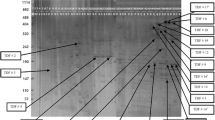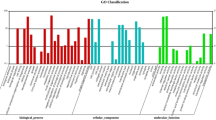Abstract
To investigate the molecular mechanisms of Al3+-stress in blueberry, a cDNA-amplified fragment length polymorphism (cDNA-AFLP) analysis was employed to identify Al-regulated genes in roots of contrasting genotypes of highbush blueberry (Brigitta, Al3+-resistant and Bluegold, Al3+-sensitive). Plants grown in hydroponic culture were treated with 0 and 100 μM Al3+ and collected at different times over 48 h. Seventy transcript-derived fragments (TDFs) were identified as being Al3+ responsive, 31 of which showed significant homology to genes with known or putative functions. Twelve TDFs were homologous to uncharacterized genes and 27 did not have significant matches. The expression pattern of several of the genes with known functions in other species was confirmed by quantitative relative real-time RT-PCR. Twelve genes of known or putative function were related to cellular metabolism, nine associated to stress responses and other transcription and transport facilitation processes. Genes involved in signal transduction, photosynthetic and energy processes were also identified, suggesting that a multitude of processes are implicated in the Al3+-stress response as reported previously for other species. The Al3+-stress response genes identified in this study could be involved in Al3+-resistance in woody plants.



Similar content being viewed by others
Abbreviations
- cDNA-AFLP:
-
DNA complementary to RNA-amplified fragment length polymorphism
- TDF:
-
Transcript derived fragment
- Aluminum:
-
Al3+
References
Piljac-Žegarac, J., Belščak, A., & Piljac, A. (2009). Antioxidant capacity and polyphenolic content of blueberry (Vaccinium corymbosum L.) leaf infusions. Journal of Medicinal Food, 12, 608–614.
Vega-Gálvez, A., Lemus-Mondaca, R., Tello-Ireland, C., Miranda, M., & Yagnam, F. (2009). Kinetic study of convective drying of blueberry variety O’Niel (Vaccinium corymbosum L.). Chilean Journal of Agricultural Research, 69, 171–178.
Kochian, L. V., Piñeros, M. A., & Hoekenga, O. A. (2005). The physiology, genetics and molecular biology of plant aluminum resistance and toxicity. Plant and Soil, 274, 175–195.
Mora, M. L., Rosas, A., Ribera, A., & Rengel, Z. (2009). Differential tolerance to Mn toxicity in perennial ryegrass genotypes: involvement of antioxidative enzymes and root exudation of carboxylates. Plant and Soil, 320, 79–89.
Inostroza-Blancheteau, C., Soto, B., Ibáñez, C., Ulloa, P., Aquea, F., Arce-Johnson, P., et al. (2010). Mapping of aluminum tolerance loci in cereals: Tool available for crop breeding. Electronic Journal of Biotechnology, 13, 4.
Ryan, P. R., Delhaize, E., & Randall, P. J. (1995). Characterization of Al-stimulated efflux of malate from apices of Al-tolerant wheat roots. Planta, 196, 103–110.
Liu, J., Magalhaes, J. V., Shaff, J., & Kochian, L. V. (2009). Aluminum-activated citrate and malate transporters from the MATE and ALMT families function independently to confer Arabidopsis aluminum tolerance. Plant Journal, 57, 389–399.
Jones, D. L., & Ryan, P. R. (2004). Nutrition/Aluminum toxicity. In D. Murphy, B. Murray, & B. Thomas (Eds.), Encyclopedia of Applied Plant Science (pp. 656–664). London: Academic Press.
Tamás, L., Huttová, J., Mistrík, I., Simonovicová, M., & Siroka, B. (2003). Aluminium-induced drought and oxidative stress in barley roots. Journal of Plant Physiology, 163, 781–784.
Yamamoto, Y., Kobayashi, Y., Devi, S. R., Rikiishi, S., & Matsumoto, H. (2002). Aluminum toxicity is associated with mitochondrial dysfunction and the production of reactive oxygen species in plant cell. Plant Physiology, 128, 63–72.
Pan, J. W., Zhu, M. Y., & Chen, H. (2001). Aluminum-induced cell death in root-tips cells of barley. Environmental and Experimental Botany, 46, 71–79.
Rodriguez-Milla, M. A., Maurer, A., Rodriguez-Huete, A., & Gustafson, J. P. (2003). Glutathione peroxidase genes in Arabidopsis are ubiquitous and regulated by abiotic stresses through diverse signaling pathways. Plant Journal, 36, 602–615.
Ezaki, B., Sasaki, K., Matsumoto, H., & Nakashima, S. (2005). Functions of two genes in aluminium (Al) stress resistance: repression of oxidative damage by the AtBCB gene and promotion of efflux of Al ions by the NtGDI1 gene. Journal of Experimental Botany, 56, 2661–2671.
Piñeros, M. A., Shaff, J. E., Manslank, H. S., Alves, V. M. C., & Kochian, L. V. (2005). Aluminum resistance in maize cannot be solely explained by root organic acid exudation comparative physiological study. Plant Physiology, 137, 231–241.
Delhaize, E., Ryan, P. R., & Randall, P. J. (1993). Aluminum tolerance in wheat (Triticum aestivum L.) II. Aluminum-stimulated excretion of malic acid from root apices. Plant Physiology, 103, 695–702.
Snowden, K. C., & Gardner, R. C. (1993). Five genes induced by aluminum in wheat (Triticum aestivum L.) roots. Plant Physiology, 103, 855–861.
Mao, C., Yi, K., Yang, L., Zheng, B., Wu, Y., Liu, F., et al. (2004). Identification of aluminium-regulated genes by cDNA-AFLP in rice (Oryza sativa L.): aluminium-regulated genes for the metabolism of cell wall components. Journal of Experimental Botany, 55, 137–143.
Watt, D. A. (2003). Aluminum-responsive genes in sugarcane: identification and analysis of expression under oxidative stress. Journal of Experimental Botany, 54, 1163–1174.
Kumari, M., Taylor, G. J., & Deyholos, M. K. (2008). Transcriptomic responses to aluminum stress in roots of Arabidopsis thaliana. Molecular Genetics and Genomics, 279, 339–357.
Snowden, K. C., Richards, K. D., & Gardner, R. C. (1995). Aluminium induced genes induction by toxic metals, low calcium, and wounding and pattern of expression in root tips. Plant Physiology, 107, 341–348.
Hamel, F., Breton, C., & Houde, M. (1998). Isolation and characterization of wheat aluminium-regulated genes: possible involvement of aluminium as a pathogenesis response elicitor. Planta, 205, 531–538.
Yang, W. Q., Goulart, B. L., & Demchak, K. (1996). The effect of aluminum media on the growth of mycorrhizal and non mycorrhizal highbush blueberry plantlets. Plant and Soil, 183, 301–308.
Reyes-Díaz, M., Alberdi, M., & Mora, M. L. (2009). Short-term aluminum stress differentially affects the photochemical efficiency of photosystem II in highbush blueberry genotypes. J Amican Society for Horticultural Science, 1, 14–21.
Bachem, C. W., van der Hoeven, R. S., de Bruijin, S. M., Vreugdenhil, D., Zabeau, M., & Visser, R. G. (1996). Visualization of differential gene expression using a novel method of RNA fingerprinting based on AFLP: analysis of gene expression during potato tuber development. Plant J, 9, 745–753.
Hoagland, D. R., & Arnon, D. I. (1959). The water culture method for growing plants without soil. California Agricultural Experimental Station, 347, 1–32.
Gambiano, G., Perrone, I., & Gribaudo, I. (2008). A rapid and effective method for RNA extraction from different tissues of grapevine and other woody plants. Phytochemical Analysis, 19, 520–525.
Aquea, F., & Arce-Johnson, P. (2008). Identification of genes expressed during early somatic embryogenesis in Pinus radiata. Plant Physiology and Biochemistry, 46, 559–568.
Naik, D., Dhanaraj, A. L., Arora, R., & Rowland, L. J. (2007). Identification of genes associated with cold acclimation in blueberry (Vaccinium corymbosum L.) using a subtractive hybridization approach. Plant Science, 173, 213–222.
Livak, K. J., & Schmittgen, T. D. (2001). Analysis of relative gene expression data using real-time quantitative PCR and the 2-ΔΔCT method. Methods, 25, 402–408.
Doncheva, S., Amenós, M., Poschenrieder, C., & Barcelo, J. (2005). Root cell patterning: a primary target for aluminium toxicity in maize. Journal of Experimental Botany, 56, 1213–1220.
Scheres, B., Benfey, P., & Dolan, L. (2002). Root development. In C. R. Somerville & E. M. Meyerowitz (Eds.), The Arabidopsis Book. Rockville: American Society of Plant Biologists.
Wolters, H., & Jürgens, G. (2009). Survival of the flexible: hormonal growth control and adaptation in plant development. Natural Reviews Genetics, 10, 305–317.
Massot, N., Nicander, B., Barcelo, J., Poschenrieder, C., & Tillberg, E. (2002). A rapid increase in cytokinin levels and enhanced ethylene evolution precede Al3+-induced inhibition of root growth in bean seedlings (Phaseolus vulgaris L). Plant Growth Regulation, 37, 105–112.
Sun, P., Tian, Q. Y., Chen, J., & Zhang, W. H. (2010). Aluminium-induced inhibition of root elongation in Arabidopsis is mediated by ethylene and auxin. Journal of Experimental Botany, 61, 347–356.
Christians, M. J., Gingerich, D. J., Hansen, M., Binder, B. M., Kieber, J. J., & Vierstra, R. D. (2009). The BTB ubiquitin ligases ETO1, EOL1 and EOL2 act collectively to regulate ethylene biosynthesis in Arabidopsis by controlling type-2 ACC synthase levels. Plant Journal, 57, 332–345.
Gray, W. M., Hellmann, H., Dharmasiri, S., & Estelle, M. (2002). Role of the Arabidopsis RING-H2 protein RBX1 in RUB modification and SCF function. Plant Cell, 14, 2137–2144.
Rengel, Z., & Zhang, W. H. (2003). Role of dynamics of intracellular calcium in aluminium-toxicity syndrome. New Phytologist, 159, 295–314.
Kurita, H., Nakatomi, A., Shimahara, H., Yazawa, M., & Ohki, S. (2005). Al3+ interaction sites of calmodulin and the Al3+ effect on target binding of calmodulin. Biochemical and Biophysical Research Communications, 333, 1060–1065.
Wang, J. W., & Kao, C. H. (2006). Aluminum-inhibited root growth of rice seedlings is mediated through putrescine accumulation. Plant and Soil, 288, 373–381.
Wen, X. P., Ban, Y., Inoue, H., Matsuda, N., & Moriguchi, T. (2009). Aluminum tolerance in a spermidine synthase-overexpressing transgenic European pear is correlated with the enhanced level of spermidine via alleviating oxidative status. Journal of Plant Physiology, 66, 471–478.
Chen, W., Xu, C., Zhao, B., Wang, X., & Wang, Y. (2008). Improved Al tolerance of saffron (Crocus sativus L.) by exogenous polyamines. Acta Physiologiae Plantarum, 30, 121–127.
Park, S., Li, J., Pittman, J. K., Berkowitz, G. A., Yang, H., Undurraga, S., et al. (2005). Up-regulation of a H+-pyrophosphatase (H+-PPase) as a strategy to engineer drought-resistant crop plants. Proceedings of the National Academy of Sciences of the United States of America, 102, 18830–18835.
Basu, A., Basu, U., & Taylor, G. J. (1994). Induction of microsomal membrane proteins in roots of an aluminum resistant cultivar of Triticum aestivum L under conditions of aluminum stress. Plant Physiology, 104, 1007–1013.
Hamilton, C. A., Good, A. G., & Taylor, G. J. (2001). Induction of vacuolar ATPase and mitochondrial ATP synthase by aluminum in an aluminum-resistant cultivar of wheat. Plant Physiology, 125, 2068–2077.
Gebbie, L. K., Burn, J. E., Hocart, C. H., & Williamson, R. E. (2005). Genes encoding ADP-ribosylation factors in Arabidopsis thaliana L Heyn.; genome analysis and antisense suppression. Journal of Experimental Botany, 56, 1079–1091.
Ezaki, B., Sivaguru, M., Ezaki, Y., Matsumoto, H., & Gardner, R. C. (1999). Acquisition of aluminum tolerance in Saccharomyces cerevisiae by expression of the BCB or NtGDI1 gene derived from plants. FEMS Microbiology Letters, 171, 81–87.
Frith, M. C., Pheasant, M., & Mattick, J. S. (2005). The amazing complexity of the human transcriptome. European Journal of Human Genetics, 13, 894–897.
Carninci, P., Kasukawa, T., Katayama, S., Gough, J., Frith, M. C., Maeda, N., et al. (2005). FANTOM Consortium, RIKEN Genome Exploration Research Group and Genome Science Group (Genome Network Project Core Group), The transcriptional landscape of the mammalian genome. Science, 309, 1559–1563.
Acknowledgments
This work was financially supported by the Fruit Consortium, 07Genoma01, the Millennium Nucleus for Plant Functional Genomics (P06-009-F), Fondecyt Project No. 11080231 and Fondecyt Project No. 1080372. C. Inostroza-Blancheteau was supported by a PhD fellowship from CONICYT-Chile and UFRO. F. Aquea is supported by a Postdoctoral Project “Programa Bicentenario de Ciencia y Tecnología/CONICYT-Banco Mundial” PSD74-2006. We thank Michael Handford for assistance in language support.
Author information
Authors and Affiliations
Corresponding author
Rights and permissions
About this article
Cite this article
Inostroza-Blancheteau, C., Aquea, F., Reyes-Díaz, M. et al. Identification of Aluminum-Regulated Genes by cDNA-AFLP Analysis of Roots in Two Contrasting Genotypes of Highbush Blueberry (Vaccinium corymbosum L.). Mol Biotechnol 49, 32–41 (2011). https://doi.org/10.1007/s12033-010-9373-3
Published:
Issue Date:
DOI: https://doi.org/10.1007/s12033-010-9373-3




